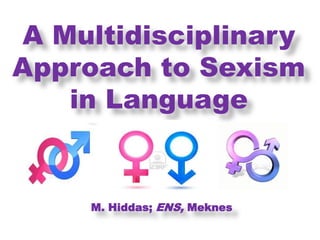
M. hiddas power point presentation
- 1. A Multidisciplinary Approach to Sexism in Language M. Hiddas; ENS, Meknes
- 2. Sexism as a concept and behaviour • The term sexism was coined by Pauline M. Leet in US in 1965 as a model on Racism. • Sexism in language involves words or expressions that carry negative, discriminatory attitudes towards people on gender bases. • People’s gender: involving mainly males and females. • Male sexism and Female sexism.
- 3. Male sexism in language • Theories and constructs have been developed since first feminist wave. Worth mentioning: • Hostile versus benevolent sexism - Hostile sexism: manifest in people’s words and actions. - Benevolent sexism: perceives women as “pure creatures who ought to be protected, supported, and adored and whose love is necessary to make a man complete” (Glick and Fiske, 2001: 109).
- 4. Benevolent sexism: A formidable enemy to women; it goes camouflaged under the cover of cherishment. Many women like or accept being cherished and, therefore, admit sexism massively and easily. It aims to keep women socially and psychologically docile and inferior to men. It justifies and feeds hostile sexism It averts criticism.
- 5. Generic “he” • Dear Ladies and gentlemen, if someone loses his way, no one can help him; he can help himself by using the map which has now become his. • Dear fathers, if someone loses his way, no one can help him; he can help himself by using the map which has now become his. • Dear mothers, if someone loses his way, no one can help him; he can help himself by using the map which has now become his.
- 6. Generic “she”! • Dear ladies and gentlemen, if someone loses her way, no one can help her; she can help herself by using the map which has now become hers.
- 7. A direct feminist riposte Generic “she”
- 8. Alternatives to generic “he” • Reformulation: plural they, generic you, plural eg: If someone loses his way, they can use the map… • Replacement: he or she -- he/she -- s/he -- (s)he -- she or he -- she/he thon , co , se , yo , e, hu , zhe , phe
- 9. • Generic “man”: All men are mortal, Sara is a man; therefore, Sara is mortal. (Mind a feminist riposte!) • Asymmetrical pairs: [bachelor – spinster] - Bachelor: a man who has never been married. - Spinster: a woman who is not married, especially an older woman who is not likely to marry.
- 10. • Longer sexist statements: - Women are the snares of Satan. - Long hair, short wit. - Behind every successful man is a woman. - Beware two things: a winter blue sky and a praying crone. - All women are whores, except those who can’t (be so).
- 11. Do generic words actually enhance generic images?
- 12. 115 Baccalaureate students 52 males 63 females
- 14. Singer
- 15. Impartial linguistic representation Female Male image image 50% 50%
- 16. Result: general mental representation Female Male image image 42% 58%
- 17. 41,15% - 58,85% 42,30% - 57,70% 60.00% 50.00% 40.00% Female image 30.00% Male Image 20.00% 10.00% 0.00% Females Males
- 18. Conclusion to the study • Which enhances which, sexism or language? - Language reflects rather than generates sexism. - Language reflects our thoughts rather than tailors them.
- 19. General conclusion • Sexism in language is a global issue. • There is an interactive relationship between language and sexism, but language reflects rather than generates sexism; language reflects our thoughts rather than tailors them. • Sexism is a matter of long sociohistorical heritage, mirrored in our acts and words. • Language sexism is an additional burden on the part of the language learner and user. • English suffers from many inconsistencies, one of which is sexism. • English needs a rational reform.
